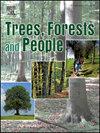Biomass accumulation and carbon stocks of soil and tree components of different agroforestry systems in tropical moist regions of Bangladesh
IF 2.7
Q1 FORESTRY
引用次数: 0
Abstract
The increase in greenhouse gases has made global warming, the most pressing environmental challenge requiring prompt action. Agroforestry is globally recognized to mitigate this problem due to its significant potential to capture atmospheric carbon dioxide and provide various ecosystems benefits including food security. However, very few studies have been conducted on estimating biomass accumulation and carbon (C) stock in different agroforestry systems in the tropical moist climatic regions of Bangladesh. The current study was carried out to evaluate the biomass accumulation and C stock under four different agroforestry systems: Timber tree-based agroforestry system (TAS), fruit tree-based agroforestry system (FAS), medicinal plant-based agroforestry system (MPAS), and mixed tree-based agroforestry system (MAS) under tropical moist climatic conditions in Madhupur, Bangladesh. The sites and types of the agroforestry systems were selected based on dominance and accessibility. A total of 108 plots (10 m × 10 m) were randomly selected for data collection viz. plant density, height and diameter of the tree species, and collection of soil samples. A nondestructive sampling method followed by allometric equations was used to determine the biomass of the tree species. Overall, 216 Soil samples from two layers (0–15 cm and 15–30 cm depths) were also collected from randomly selected points to determine soil bulk density and soil organic carbon (SOC). The data was collected in four agroforestry systems: TAS, FAS, MPAS, and MAS with the plant density of 678, 611, 633 and 722 trees ha-1 respectively. Results showed that tree C stock among the four agroforestry systems was significantly different, with a maximum stock of 226.05 t ha-1 in MAS, and it was 29.99 %, 37.92 % and 54.81 % greater than the carbon stock of TAS, MPAS, and FAS, respectively. The highest SOC was estimated (51.22 t ha-1) in MAS, at 0–30 cm depth followed by 42.37 t ha-1, 41.00 t ha-1, and 37.53 t ha-1 for TAS, MPAS, and FAS, respectively. Similarly, the amount of total carbon stock (C stock of trees and SOC) of the agroforestry systems was found in the order of MAS > TAS > MPAS > FAS. The results suggested that MAS, with the highest biomass accumulation and C storage are the most effective agroforestry systems compared to the others in requisites of environmental benefits particularly in carbon storage.
孟加拉国热带潮湿地区不同农林业系统土壤和树木组分的生物量积累和碳储量
温室气体的增加使全球变暖成为最紧迫的环境挑战,需要迅速采取行动。全球公认农林业可以缓解这一问题,因为它具有捕获大气二氧化碳的巨大潜力,并提供包括粮食安全在内的各种生态系统效益。然而,很少有研究对孟加拉国热带潮湿气候区不同农林业系统的生物量积累和碳(C)储量进行估算。本研究旨在评估孟加拉国Madhupur热带湿润气候条件下4种不同农林业系统(以木材为基础的农林业系统(TAS)、以果树为基础的农林业系统(FAS)、以药用植物为基础的农林业系统(MPAS)和以树木为基础的混合农林业系统(MAS))的生物量积累和碳储量。根据优势度和可达性选择农林业系统的立址和类型。随机选取108个样地(10 m × 10 m)进行数据采集,包括植物密度、树种高度和直径、土壤样品采集。采用非破坏性取样法,结合异速生长方程,测定了该树种的生物量。总体而言,在0-15 cm和15-30 cm两层随机取样216份土壤样品,测定土壤容重和土壤有机碳(SOC)。数据采集于4个农林业系统:TAS、FAS、MPAS和MAS,植物密度分别为678、611、633和722株ha-1。结果表明:4个农林业系统间的树碳储量差异显著,MAS最大储量为226.05 t ha-1,分别比TAS、MPAS和FAS高29.99%、37.92%和54.81%;在0 ~ 30 cm深度,MAS的SOC最高(51.22 t ha-1),其次是TAS、MPAS和FAS,分别为42.37 t ha-1、41.00 t ha-1和37.53 t ha-1。同样,农林业系统的总碳储量(树木碳储量和有机碳储量)的大小依次为MAS >;助教比;海洋保护区的在FAS。结果表明,与其他农林业系统相比,具有最高生物量积累和碳储量的MAS系统在环境效益方面是最有效的,特别是在碳储量方面。
本文章由计算机程序翻译,如有差异,请以英文原文为准。
求助全文
约1分钟内获得全文
求助全文
来源期刊

Trees, Forests and People
Economics, Econometrics and Finance-Economics, Econometrics and Finance (miscellaneous)
CiteScore
4.30
自引率
7.40%
发文量
172
审稿时长
56 days
 求助内容:
求助内容: 应助结果提醒方式:
应助结果提醒方式:


